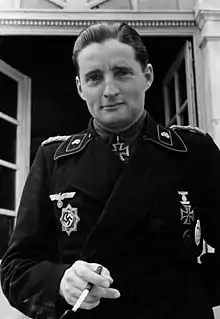Hermann von Oppeln-Bronikowski | |||||||||||||||
|---|---|---|---|---|---|---|---|---|---|---|---|---|---|---|---|
 Hermann von Oppeln-Bronikowski, June 1944 | |||||||||||||||
| Born | 2 January 1899 Berlin, Kingdom of Prussia, German Empire | ||||||||||||||
| Died | 19 September 1966 (aged 67) Gaißach, Bavaria, West Germany | ||||||||||||||
| Allegiance | |||||||||||||||
| Rank | Generalmajor | ||||||||||||||
| Commands held | 20th Panzer Division | ||||||||||||||
| Battles/wars | World War I World War II | ||||||||||||||
| Awards | Knight's Cross of the Iron Cross with Oak Leaves and Swords | ||||||||||||||
| Sports career | |||||||||||||||
| Country | |||||||||||||||
| Sport | Equestrian | ||||||||||||||
Medal record
| |||||||||||||||
Hermann Leopold August von Oppeln-Bronikowski (2 January 1899 – 19 September 1966) was an Olympic equestrian, winning a gold medal in the team dressage at the 1936 Olympics. He later served as a panzer general during World War II.
As a lieutenant during World War I, he was awarded the Iron Cross in 1918.
During World War II, he served with distinction in Poland in 1939 and then on the Russian Front, commanding several tanks that were knocked out and personally leading several ad hoc attacks.
Oppeln-Bronikowski led the desperate attack of the 22nd Panzer Division on the 19th of November 1943 in an attempt to forestall the encirclement of German forces in Stalingrad.
He was considered an excellent panzer commander, but had problems with higher authority as he was an excessive drinker. In one particular instance, as an Oberst commanding the 100th Panzer Division at Falaise, France; he was visited at 8:15 in the morning on 11 May 1944 by Rommel, who was satisfied with the forces' defensive preparations, but said to him – You lazy stinkers, what happens if the enemy invasion begins before 8:30! Oppeln-Bronikowski, who had gone to sleep in his now crumpled and tobacco-smelling uniform, and still had alcohol on his breath, could only reply Catastrophe and Rommel laughed.[1] Oppeln-Bronikowski led a panzer counter-attack on the invading forces immediately after the D-Day Invasion, and was told by his commanding officer that if he did not throw the British back into the sea, the war would be lost. Some of his tanks managed to reach the coast, but were soon forced to withdraw, with the counter-attack subsequently failing.[2] D-Day was the major turning point of the war on the Western front.
He commanded the 20th Panzer Division and was awarded the Knight's Cross of the Iron Cross with Oak Leaves and Swords.
He was among Cornelius Ryan's interviewees when Ryan was preparing The Longest Day.
He died of a heart attack in 1966.
Awards
- Iron Cross (1914) 2nd Class (28 May 1918) & 1st Class (14 October 1918)[3]
- Clasp to the Iron Cross (1939) 2nd Class (25 September 1939) & 1st Class (10 November 1939)[3]
- German Cross in Gold on 7 August 1943 as Oberst in Panzer-Regiment 11[4]
- Knight's Cross of the Iron Cross with Oak Leaves and Swords
- Knight's Cross on 1 January 1943 as Oberst and commander of Panzer-Regiment 204[5]
- Oak Leaves on 28 July 1944 as Oberst and commander of Panzer-Regiment 22[5]
- Swords on 17 April 1945 as Generalmajor and commander of the 20. Panzer-Division[5]
References
Citations
Bibliography
- Patzwall, Klaus D.; Scherzer, Veit (2001). Das Deutsche Kreuz 1941 – 1945 Geschichte und Inhaber Band II [The German Cross 1941 – 1945 History and Recipients Volume 2] (in German). Norderstedt, Germany: Verlag Klaus D. Patzwall. ISBN 978-3-931533-45-8.
- Scherzer, Veit (2007). Die Ritterkreuzträger 1939–1945 Die Inhaber des Ritterkreuzes des Eisernen Kreuzes 1939 von Heer, Luftwaffe, Kriegsmarine, Waffen-SS, Volkssturm sowie mit Deutschland verbündeter Streitkräfte nach den Unterlagen des Bundesarchives [The Knight's Cross Bearers 1939–1945 The Holders of the Knight's Cross of the Iron Cross 1939 by Army, Air Force, Navy, Waffen-SS, Volkssturm and Allied Forces with Germany According to the Documents of the Federal Archives] (in German). Jena, Germany: Scherzers Militaer-Verlag. ISBN 978-3-938845-17-2.
- Thomas, Franz (1998). Die Eichenlaubträger 1939–1945 Band 2: L–Z [The Oak Leaves Bearers 1939–1945 Volume 2: L–Z] (in German). Osnabrück, Germany: Biblio-Verlag. ISBN 978-3-7648-2300-9.